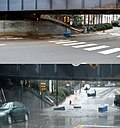Flash flood
Flash flood is a rapid flooding of low-lying areas in less than six hours, often caused by intense rainfall from a thunderstorm or several thunderstorms. Flash floods are distinguished from regular floods by their speed and unpredictability. They can also occur from the collapse of a man-made structure or ice dam. The rapid nature of flash floods makes them extremely dangerous, capable of moving boulders, tearing out trees, destroying buildings, and obliterating bridges. Flash floods can also trigger catastrophic mudslides, and the rapid rise in water level can lead to significant erosion of the land.
Causes[edit]
Flash floods are primarily caused by heavy rainfall. Other factors that can contribute to flash flooding include:
- Topography: Areas with steep slopes are more susceptible to flash floods.
- Soil conditions: Saturated or impervious soils, such as those found in urban areas, do not absorb water well, leading to rapid runoff.
- Land use: Urbanization increases runoff by reducing the amount of land available for water absorption.
- Hydrology: Small rivers and streams with a limited capacity to carry water are more likely to flood quickly.
Impacts[edit]
The impacts of flash floods are both immediate and long-term, including:
- Loss of life and injury to people caught in the flood.
- Damage to infrastructure, homes, and businesses.
- Disruption of utilities and services.
- Environmental damage, including erosion and loss of habitat.
- Economic impacts on local and regional economies.
Prevention and Mitigation[edit]
Efforts to prevent or mitigate the effects of flash floods include:
- Flood forecasting and warning systems: Providing advance notice of potential flooding.
- Urban planning: Implementing zoning laws and building codes to prevent development in flood-prone areas.
- Flood control: Constructing dams, levees, and reservoirs to control water flow.
- Rainwater harvesting: Capturing runoff to reduce the volume of water during heavy rains.
- Vegetation management: Planting trees and other vegetation to increase soil absorption and reduce runoff.
Response[edit]
Responding to a flash flood involves:
- Evacuation of people from areas at risk.
- Search and rescue operations for those trapped or affected by the flood.
- Provision of emergency shelter, food, and medical care.
- Assessment and repair of damaged infrastructure.
- Support for affected individuals and communities in the recovery process.
See Also[edit]

This article is a environment-related stub. You can help WikiMD by expanding it!
-
Main and University, Charlottesville during flash flood
-
Driving through flash flood
-
Gobi Desert flood
-
Minor flood
-
Canandaigua flood July 23, 2017 barn flooded
-
Ein Avdat flood
Ad. Transform your life with W8MD's Budget GLP-1 injections from $75


W8MD offers a medical weight loss program to lose weight in Philadelphia. Our physician-supervised medical weight loss provides:
- Weight loss injections in NYC (generic and brand names):
- Zepbound / Mounjaro, Wegovy / Ozempic, Saxenda
- Most insurances accepted or discounted self-pay rates. We will obtain insurance prior authorizations if needed.
- Generic GLP1 weight loss injections from $75 for the starting dose.
- Also offer prescription weight loss medications including Phentermine, Qsymia, Diethylpropion, Contrave etc.
NYC weight loss doctor appointmentsNYC weight loss doctor appointments
Start your NYC weight loss journey today at our NYC medical weight loss and Philadelphia medical weight loss clinics.
- Call 718-946-5500 to lose weight in NYC or for medical weight loss in Philadelphia 215-676-2334.
- Tags:NYC medical weight loss, Philadelphia lose weight Zepbound NYC, Budget GLP1 weight loss injections, Wegovy Philadelphia, Wegovy NYC, Philadelphia medical weight loss, Brookly weight loss and Wegovy NYC
|
WikiMD's Wellness Encyclopedia |
| Let Food Be Thy Medicine Medicine Thy Food - Hippocrates |
Medical Disclaimer: WikiMD is not a substitute for professional medical advice. The information on WikiMD is provided as an information resource only, may be incorrect, outdated or misleading, and is not to be used or relied on for any diagnostic or treatment purposes. Please consult your health care provider before making any healthcare decisions or for guidance about a specific medical condition. WikiMD expressly disclaims responsibility, and shall have no liability, for any damages, loss, injury, or liability whatsoever suffered as a result of your reliance on the information contained in this site. By visiting this site you agree to the foregoing terms and conditions, which may from time to time be changed or supplemented by WikiMD. If you do not agree to the foregoing terms and conditions, you should not enter or use this site. See full disclaimer.
Credits:Most images are courtesy of Wikimedia commons, and templates, categories Wikipedia, licensed under CC BY SA or similar.
Translate this page: - East Asian
中文,
日本,
한국어,
South Asian
हिन्दी,
தமிழ்,
తెలుగు,
Urdu,
ಕನ್ನಡ,
Southeast Asian
Indonesian,
Vietnamese,
Thai,
မြန်မာဘာသာ,
বাংলা
European
español,
Deutsch,
français,
Greek,
português do Brasil,
polski,
română,
русский,
Nederlands,
norsk,
svenska,
suomi,
Italian
Middle Eastern & African
عربى,
Turkish,
Persian,
Hebrew,
Afrikaans,
isiZulu,
Kiswahili,
Other
Bulgarian,
Hungarian,
Czech,
Swedish,
മലയാളം,
मराठी,
ਪੰਜਾਬੀ,
ગુજરાતી,
Portuguese,
Ukrainian






